Seven Things to Know/Do Before the Open
2016 02 12
Seven Things to Know/Do Before the Open
2016 02 12
It's 6am. Your eight-year-old's soccer practice is in one hour. You know she should eat something, but what? And how do you get him to EAT?
During tournaments, kids sometimes play three intense games in a single day--especially at the end of the tournament, when there's more on the line. If it's a teen, we could be talking one long 80 minute game. "A single bad shift change can cost you the tournament." Little things matter. Nutrition is a BIG thing. Many parents believe their kids can eat virtually anything without affecting their performance. As a coach, I can testify to just how wrong they are. A kid who fades out 40 minutes into practice will get 33% less coaching time, because they're too tired to improve. A kid who's too hyper at the start of practice will usually distract the coach, or earn a few laps, which detracts from his time to learn. Kids who don't eat breakfast simply won't play their best in the third period. An overstimulated kid will probably draw an unnecessary penalty or draw an unnecessary offside. Fortunately, there's an answer, and it's not force-feeding your kid. Here's an easy way to make sure they're getting what they need (and will want to eat it!) 1.Protein You know protein builds muscles. But on game day, eating protein can help by slowing down the absorption of carbohydrates. Without fully explaining the Glycemic Index, here's how carbs work: some break down slowly, giving you sustained energy; some break down quickly, giving you peaks and valleys. Protein slows that breakdown, helping with sustaining energy levels for longer. You need protein and/or fat with carbs on game day. 2.Carbs Your body primarily runs on carbohydrates during sport (though there's some fat metabolism, too.) But just like gas in a racecar, you don't want to run out. If you're eating sugar, white flour or fruit without anything else, you'll get a massive energy dump at first...and then nothing when you need it later. At Crossfit South Bend, we explain carbohydrate breakdown as a thermometer: let's say you want to keep your house heated to 20 degrees. If you burn sugar, that thermometer will jump to 40, and then quickly drop to 10. If you burn grains (even "whole wheat") you'll pop up to 35, and then drop to 15 pretty quickly. But if you're burning vegetables, you'll go up to 25, then back to 18. And if you add protein or fat to the meal, you'll hold 20 degrees for a long time. Eat vegetables, or combine protein and/or fat with your carbs to keep that energy level consistent. What are some of the worst carbs to eat? Breakfast bars. Muffins. Bagels. 3.Fat Fats don't make you fat. Kids need fat in their diet (so do adults, especially in South Bend, where our skin dries out and our brain gets depressed in the winter.) Fats are a secondary energy source. When the carbs are gone, fats fuel the fire. Use nuts and seeds to provide healthy fats. Heck, eat bacon: I'd rather coach a kid who ate bacon for breakfast than one who had a bagel. BONUS: The carb-up myth.
Some parents and coaches believe that kids should "carb up" before a practice or game, and feed them a bagel or pasta. This isn't true, will probably decrease performance, and should be stopped.
Feeding a kid a bunch of grain-based food immediately before practice will slow him down. Grains pull water out of the muscle and into the stomach, causing cramps, an "overfull" feeling, and sluggishness. Want to slow down a racehorse? Give him a pail of grain right before a race. Want to slow down your kid? Do the same.
If given a giant bowl of pasta the night before an early practice, your child's stomach will be clear. But the insulin spike from the carb-heavy meal will leave them with a sugar crash in the morning; they'll feel tired, crabby and sluggish until they eat more sugar, and then ride that roller-coaster all day.
Even most marathon runners, who need prolonged energy at low levels over several hours, are starting to trend away from this bad habit and instead opt for a combination of carbs, protein and fat the night before a race.
Adults tend to choose foods based on taste, but research shows this isn't true for kids. Kids make food choices based on, in this order:
1. Novelty
2. Texture
3. Taste.
"Novelty" can mean appearance, or activity surrounding the food, or presentation. If you look at packaging on "kid food" as an adult, you'll think the manufacturer went way overboard on bright colours and shooting stars. But they know better: to a kid, the shiniest box contains the best-tasting food. Luckily, we can use their knowledge for our own (less-evil) purposes.
Packaging food in a unique way, arranging it on the plate to make a picture, making it finger-edible, placing it in a different spot in the house...kids' brains are wired to pay attention to novelty. These things all help. Filling a special "soccer day" bowl with grapes, nuts and cheese to eat on the way to the rink can help. A picnic on the floor while sorting soccer equipment can also help. A final tip: turn off the tv while getting ready in the morning; no meal can compare to the shiny distractions on the screen. Letting kids choose their fruit in the grocery store can also help, because their sense of ownership will combine with the novelty factor.
Texture: in the morning, stick to crunchier, more texture-rich foods. While some kids will eat a banana (or yogurt) in the morning, cereal companies bank on how a food FEELS when it's being eaten. It's psychological, but few people wake up starving, and eating soggy cereal is unappealing anytime. What's crunchy? Fruit. Nuts.
Taste: It has to taste good, but that doesn't mean you need sugary cereal or fake yogurt in tubes. "Natural" sugars like syrup and honey aren't better than table sugar, but fruit goes a long way.
Your kid doesn't need a big breakfast, and it doesn't have to be perfect every time. Some cut up fruit or raisins; a little handful of nuts; and a piece of cheese or stick of bacon will go a long way. But when a kid hops out of the back seat with a Tim Horton's muffin and a hot chocolate, her coach knows she'll be hyper for the first ten minutes, then tired and cranky for the next 50.
PRESENTING THIS TO YOUR KIDS
Make sure you implement this early on in training, not just on game days. Typically you don't want to change anything up on game day that you hadn't tried and tested extensively during training - meaning. If your kid has spent the entire training season eating spaghetti and chocolate milk, don't change their diet aggressively for just one day, keep the habit throughout the season.
GOOD-BETTER-BEST
We approach eating on a scale of "Good-Better-Best."
Good: they ate something. This isn't enough for athletes, but kids who are just lazing around the house can get by with cereal in the morning.
Better: they had some protein with their breakfast carbs. Cereal bars can even be okay if paired with an egg or bacon.
Best: they practiced solid nutrition for at least three days before a tournament. Treats once every three days or so (rather than 3x/day.)
"Eat meat and vegetables, nuts and seeds, some fruit, little starch and no sugar." - Greg Glassman, founder of CrossFit.
Need more help? We'll come and talk to parents on your team for FREE. Email Carl@crossfitsouthbend.com
Or if you are looking to get your kid or teen training at CrossFit South Bend - Click here to Schedule a Free No Sweat Intro with us at CrossFit South Bend
During the No Sweat Intro we will meet for a private 20 minute chat about your goals - your kids goals, and what CrossFit South Bend can do to help you and your family to achieve those goals. No pressure, no obligation. Just a chance to see if CrossFit South Bend is a good fit for your family.
[/text_output][/vc_column][/vc_row]
BONUS: The carb-up myth.
Some parents and coaches believe that kids should "carb up" before a practice or game, and feed them a bagel or pasta. This isn't true, will probably decrease performance, and should be stopped.
Feeding a kid a bunch of grain-based food immediately before practice will slow him down. Grains pull water out of the muscle and into the stomach, causing cramps, an "overfull" feeling, and sluggishness. Want to slow down a racehorse? Give him a pail of grain right before a race. Want to slow down your kid? Do the same.
If given a giant bowl of pasta the night before an early practice, your child's stomach will be clear. But the insulin spike from the carb-heavy meal will leave them with a sugar crash in the morning; they'll feel tired, crabby and sluggish until they eat more sugar, and then ride that roller-coaster all day.
Even most marathon runners, who need prolonged energy at low levels over several hours, are starting to trend away from this bad habit and instead opt for a combination of carbs, protein and fat the night before a race.
Adults tend to choose foods based on taste, but research shows this isn't true for kids. Kids make food choices based on, in this order:
1. Novelty
2. Texture
3. Taste.
"Novelty" can mean appearance, or activity surrounding the food, or presentation. If you look at packaging on "kid food" as an adult, you'll think the manufacturer went way overboard on bright colours and shooting stars. But they know better: to a kid, the shiniest box contains the best-tasting food. Luckily, we can use their knowledge for our own (less-evil) purposes.
Packaging food in a unique way, arranging it on the plate to make a picture, making it finger-edible, placing it in a different spot in the house...kids' brains are wired to pay attention to novelty. These things all help. Filling a special "soccer day" bowl with grapes, nuts and cheese to eat on the way to the rink can help. A picnic on the floor while sorting soccer equipment can also help. A final tip: turn off the tv while getting ready in the morning; no meal can compare to the shiny distractions on the screen. Letting kids choose their fruit in the grocery store can also help, because their sense of ownership will combine with the novelty factor.
Texture: in the morning, stick to crunchier, more texture-rich foods. While some kids will eat a banana (or yogurt) in the morning, cereal companies bank on how a food FEELS when it's being eaten. It's psychological, but few people wake up starving, and eating soggy cereal is unappealing anytime. What's crunchy? Fruit. Nuts.
Taste: It has to taste good, but that doesn't mean you need sugary cereal or fake yogurt in tubes. "Natural" sugars like syrup and honey aren't better than table sugar, but fruit goes a long way.
Your kid doesn't need a big breakfast, and it doesn't have to be perfect every time. Some cut up fruit or raisins; a little handful of nuts; and a piece of cheese or stick of bacon will go a long way. But when a kid hops out of the back seat with a Tim Horton's muffin and a hot chocolate, her coach knows she'll be hyper for the first ten minutes, then tired and cranky for the next 50.
PRESENTING THIS TO YOUR KIDS
Make sure you implement this early on in training, not just on game days. Typically you don't want to change anything up on game day that you hadn't tried and tested extensively during training - meaning. If your kid has spent the entire training season eating spaghetti and chocolate milk, don't change their diet aggressively for just one day, keep the habit throughout the season.
GOOD-BETTER-BEST
We approach eating on a scale of "Good-Better-Best."
Good: they ate something. This isn't enough for athletes, but kids who are just lazing around the house can get by with cereal in the morning.
Better: they had some protein with their breakfast carbs. Cereal bars can even be okay if paired with an egg or bacon.
Best: they practiced solid nutrition for at least three days before a tournament. Treats once every three days or so (rather than 3x/day.)
"Eat meat and vegetables, nuts and seeds, some fruit, little starch and no sugar." - Greg Glassman, founder of CrossFit.
Need more help? We'll come and talk to parents on your team for FREE. Email Carl@crossfitsouthbend.com
Or if you are looking to get your kid or teen training at CrossFit South Bend - Click here to Schedule a Free No Sweat Intro with us at CrossFit South Bend
During the No Sweat Intro we will meet for a private 20 minute chat about your goals - your kids goals, and what CrossFit South Bend can do to help you and your family to achieve those goals. No pressure, no obligation. Just a chance to see if CrossFit South Bend is a good fit for your family.
[/text_output][/vc_column][/vc_row] 2016 01 13
CrossFit Radio Episode – CFSB about the CrossFit Open
Some stuff coming up about the CrossFit Open at CFSB for 2016 soon...
But in the meantime - here is a CrossFit Radio episode with us talking about our 2015 CrossFit Open!
2016 01 12
Simple Frequency Method
1.Take what you are trying to improve, push ups, pull ups, ring dips, etc. and hit one max unbroken set. Divide that total number by about 50-60%, that is your starting rep set.For example:
Lets say Sally can hit 5 pull ups in one sitting, we are starting with sets of 2 (round down preferably when dividing, starting easier is better than starting too hard)
SIDE NOTE: If you cannot perform a repetition at what you are trying to perform, there are a ton of scaling options to start this at, for instance...
Push Ups: Incline Push Ups, Bench Press, Knee Push Ups, Negatives
Pull Ups: Isometric Holds, Negatives, Banded Pull Ups, Ring Rows
Ring Rips: Isometric Holds, Negatives, Static Dips, Seated Dips
WARNING: Negatives make new trainee's very sore, so be careful in progressing them, no more than 10% volume a week. maybe even adding in an extra rest day.
There are many more things you can do for accessory work - I like therabands or crossover symmetry for some shoulder prehab - but this post is for those of you who are doing this stuff from home or office and don't have access to a ton of equipment.
2. Start with an amount of volume of sets that feels easy, almost too easy
For example, lets begin with 6 SETS of 2 REPETITIONS.
3. The time of day to perform
These are to be spread as evenly throughout the day as possible, one in the morning, one at night, one at lunch, and the others sprinkled throughout - if you cannot make this work there are other methods of putting it all into one block of repetitions, but thats a story for another blog post. Performing 12 repetitions split evenly throughout the day has less chance to develop volume injury issues than doing 12 all at once. If you need things split into 2-3 sets a day, or all at once because you only have access to the equipment once through the day, thats a cause to sit down and chat with us about how to make that work.
4. Number of days per week
You'll perform, this every day of the week, with the exception of Sunday.
Monday 6x2
Tuesday 6x2
Wednesday 6x2
Thursday 6x2
Friday 6x2
Saturday 6x2
Sunday REST
5. Fatigue, Injury, Managing Volume.
RULES:
*Every set should feel easy, it should never come close to failure
*You should never have to break technique to squeeze in a rep
*If you have mobility issues, address them before starting the program, you are adding volume to something, so things will tighten up a bit. If you add volume to a bad movement pattern and already tightened musculature and ignore correct movement patterns, you'll get injured.
*you can squeeze in a couple sets pretty close together, but that also increases your fatigue rate, so remember that.
*be careful of any other programs you may be doing on account that we don't program to suit YOUR volume of extra stuff you are doing, you may have to be intelligent enough to modify some movements that may push you over the edge.
6. Progressing.
Add a set, or a rep per week as recovery will allow, ONLY, and ONLY if the last week's sets were easy.
For example:
WEEK 1: 72 total weekly reps
Monday 6x2
Tuesday 6x2
Wednesday 6x2
Thursday 6x2
Friday 6x2
Saturday 6x2
Sunday REST
WEEK 2: 84 total weekly reps (14% jump in total volume)
Monday 7x2
Tuesday 7x2
Wednesday 7x2
Thursday 7x2
Friday 7x2
Saturday 7x2
Sunday REST
WEEK 3 : 108 total weekly reps (28% jump in total volume)
Monday 6x3
Tuesday 6x3
Wednesday 6x3
Thursday 6x3
Friday 6x3
Saturday 6x3
Sunday REST
WEEK 4 : 126 total weekly reps (16% jump in total volume)
Monday 7x3
Tuesday 7x3
Wednesday 7x3
Thursday 7x3
Friday 7x3
Saturday 7x3
Sunday REST
etc. Only climbing sets or reps as the last week should feel EASY - I don't like to jump more than 30% of total volume per week otherwise I noticed most people doing this (general population whose main job isn't recovering from an aggressive program) start to get little twinges and tweaks in the area worked on and usually results in a two week backpedal. But this volume of increase is depending on the athlete i'm working with as well - if you have all your ducks in a row, bigger jumps may be in order.
7. Continuing
Continue this until you hit your goal, or pass your goal, and remember - progress is NEVER a straight line. It has a few slants and zig zags in there, you may have a setback, and you may have to move in a few different directions to get to where you need to be. As you leave the area of the Novice and into intermediate, the more advanced methods and tools will become useful for you. Developing 1 pull up, is different from developing 20, which is different from developing a 150b weighted pull up. Remember that.
[/accordion_item][accordion_item parent_id="" title="Keep it simple Technique Work" id="" class="" style=""]Simple Technique Work Im going to throw some videos in here, but just remember, throwing in the attempts for muscle ups prior to having the strength to perform them, is asking for it. Technique and Skill work is meant to be non exhaustive, once you start to break technique on account of fatigue, STOP. just...stop. Keep in mind, there is much more out there than what is below, its just some good stuff that works, to some degree there can be a lot of personalization that goes into this with specific false grip work and transition work that fits your own needs. 10 minutes of practice works well Dip to upper arm support - Helps with both false grip and non false grip Toenail transition - better for false grip transitions Non false grip transition - This is video number one, he carries it through somewhere around 6 videos. False grip transitions - This is video number one of a few as well, continue through the videos a few good books - overcoming gravity by steven low, and freestyle by carl paoli. [/accordion_item][accordion_item parent_id="" title="Want us to program something specifically for you?" id="" class="" style=""]Want us to program something specifically for you? Click here to email us to let us know what you are interested in learning! Once you've emailed us, we'll look it over and give you the best idea of what its going to take to get you there.[/accordion_item][/accordion][/vc_column][/vc_row]2016 01 11

Supporting your wrists for CrossFit
2015 10 26
Training Season – by Jessica Sieff
2015 06 29
2015 04 28
Simple Strict Muscle Up Progression
2015 04 24
Tracking Progress and Using Disqus

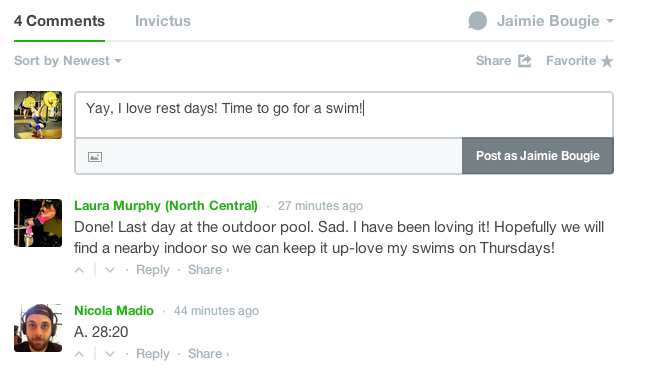
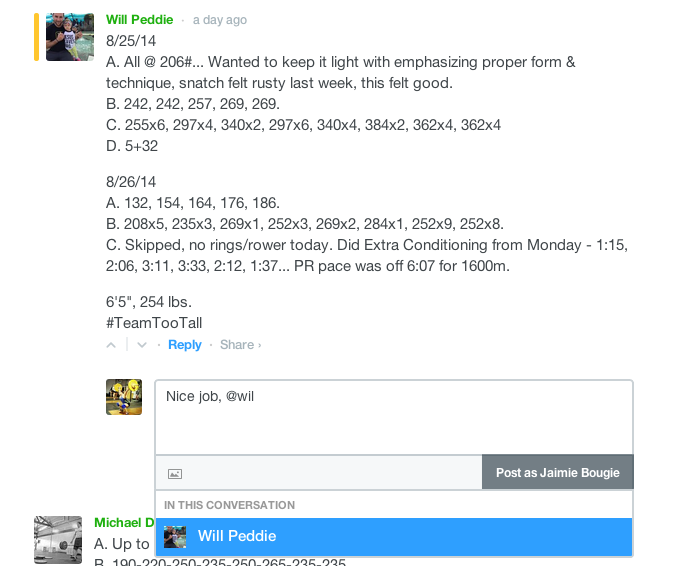
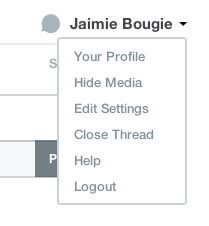
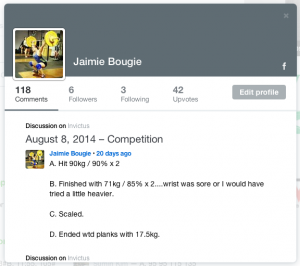
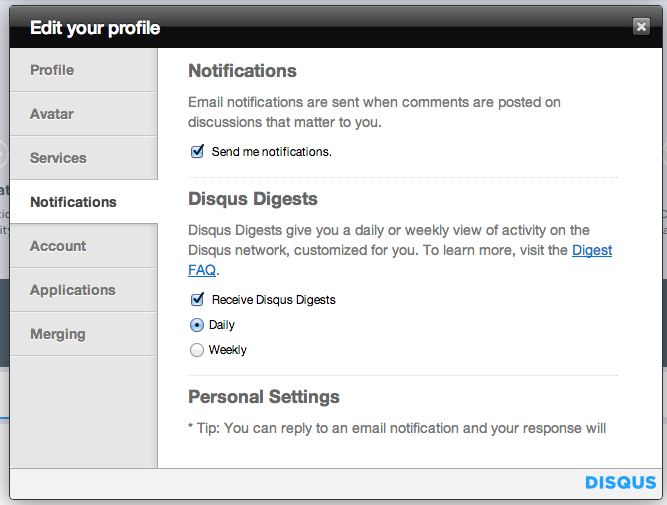
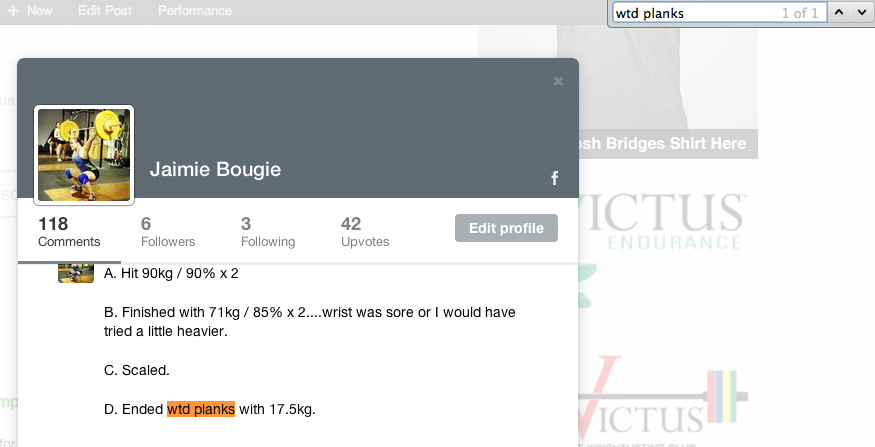 If you have any questions about Disqus that was not answered in this blog, please feel free to comment below and ask away! I’ll do my best to answer any questions you may have. Happy Posting!
If you have any questions about Disqus that was not answered in this blog, please feel free to comment below and ask away! I’ll do my best to answer any questions you may have. Happy Posting! 2014 11 05
Whole Foods and Crossfit South Bend Partnering Up!
2014 09 23